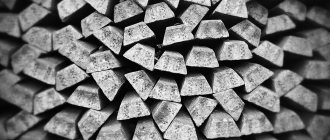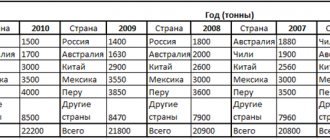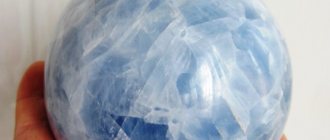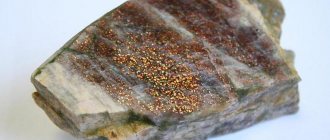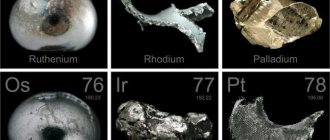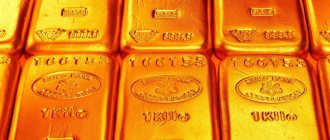Talc
- mineral with the formula Mg3Si4O10(OH)2. Synonyms: agalite (fine-fiber), steatite, wen (dense, massive). It is a greasy, crumbly powder of white (occasionally green) color. The quality of talc is determined by its whiteness. For industrial purposes, ground talc, microtalc, etc. are used. It is worth noting that talc is a mineral that is almost insoluble in water and acids. The necessary conditions for the formation of talc are a temperature of about 400 ° C, a sufficient amount of water (after the transformation of minerals from rocks rich in iron and magnesium).
- Structure
- Properties
- Morphology
- Origin
- Application
- Classification
- Physical properties
- Optical properties
- Crystallographic properties
See also:
Agate
- price and medicinal, magical properties
Physical properties and structure of diamond
Talc: what is this mineral?
It is often said that talc is the most common material. This happens because it is used in many areas of human activity.
The range is actually wide: from industry to medicine. Sometimes when mining you come across stone talc, that is, coarse-grained, it is often called steatite. For reference, see photo.
This name came to us from Arabic. It is a friable substance, essentially a powder. Sometimes they say that it feels greasy (otherwise oily) and very soft.
Most often white, but sometimes greenish, this is the norm. It is believed that the higher the quality of the talc, the whiter it is.
Of course, talc used for industrial purposes is of rather low quality, often gray or gray-green, dirty in color. The shine of talc is called pearly.
Story
The properties of talc have been known and used since ancient times:
- Archaeologists have unearthed jewelry and scarab beetles made of stone that are seven thousand years old in Egypt.
- The Sumerians made seals from talc, and ancient craftsmen created cameos.
- An outstanding creation of the Orthodox world is an icon with the face of Demetrius of Thessalonica (11th century), carved in talcum powder.
The name of the stone under which it went down in history means “pure” in Arabic and Farsi.
This characteristic was noted by the great alchemist Gregory Agricola. The first written mention and description of talc is recorded in his works (1546). He called the mineral differently - soapstone, wen, soapstone, steatite.
Characteristics of Talc Mineral
The mineral talc has a crystalline (usually rhombic) structure. In nature it occurs in the form of leafy granular layers.
It is a secondary mineral that is formed when magnesium silicates, which do not contain aluminum (Al), change their chemical composition.
We are talking about these two substances:
- pyroxene;
- amphibole.
In other words, the crystal structure remains the same, but the chemical composition undergoes significant changes.
After the substance is extracted, it is crushed, most often this is done even for industrial purposes.
There are many varieties of this mineral.
For example, Minnesotaite contains a large amount of iron. Willemseite is nickel based.
Here are these and other types:
- soapstone;
- agalite;
- Minnesotait;
- steatite;
- Willemseit.
It should be noted that steatite is also often called wen, because it has increased density and mass.
Soapstone chlorite is half talc.
MORPHOLOGY
Depending on the structure and mineral additives, some types of talc have their own names. Thus, minnesoaite is a talc in which magnesium is isomorphically replaced by iron. It has a brownish color. Willemseite - magnesium in the mineral formula is isomorphically replaced by nickel (stone color - green, blue).
Very dense, massive talc is called steatite or wen. Not so common is talc, which consists of long, tangled, parallel-fibrous, asbestos-like crystals. It is called agalite.
There are also very beautiful varieties of talc aggregate - dense, white and translucent, which tolerate stone cutting and polishing well. They are called noble talc.
In deposits, talc is found together with chlorite, clinochlore, serpentinite, tremolite, and other minerals of the pyroxene and amphibole groups. can form aggregates when mixed with chlorite (talc chlorite).
Properties of the mineral talc
Has a dull, shimmering shine.
It should be mentioned that the material is never 100% pure, unless, of course, special processing is carried out; various impurities always occur:
- iron;
- aluminum;
- calcium;
- magnesium;
- nickel.
There are other inclusions, but they already occupy hundredths of a percent, so there is little point in listing them.
Some mineral plates are translucent. The cleavage is perfect. Hardness: 1 on the Mohs scale.
It should be added that the mineral is in the very last place in this table. Density - 2.7 g/cm3.
Inert towards acids and alkalis. This property is actively used in industry when talc is used.
Cosmetic uses of talc
As noted, talc is used very widely.
The question of why talc is needed disappears by itself, since it is present everywhere in our lives. A separate article is the use of the substance at home. For example, newborns are treated with flavored talc (baby talc).
Girls use the substance for sugaring, that is, to remove hair on their legs. By the way, the word “sugaring” comes from the word “sugar”, so it is not entirely correct to use it for talc.
We are talking about the use of talcs in cosmetics, but we must remember that before using this or that product, you need to read the description of the drug.
After which you can safely use it. Of course, men's use of talcum powder also occurs. For example, in sports.
It is quite difficult to replace talc here, since it absorbs water well, and synthetic powders can contain allergens and irritate the skin.
It can be summarized by the fact that the most often used is crushed mineral powder.
Talc for the body is very good, it produces a positive effect and does not allow moisture to leave the skin.
Type of substance
Additive E 553b refers to magnesium silicates.
Performs the same functions as other compounds in this group: acidity stabilizer, anti-caking agent. It is a magnesium salt of silicic acid.
The product is obtained by calcining natural talc and other minerals, mainly consisting of hydrous magnesium silicate (for example, chrysotile).
Another method of obtaining the substance is popular: in special autoclaves, silicate glasses crystallize at temperatures from 1000 to 1100 ° C.
Industrial applications of talc
Of course, the material can be used in everyday life as shoe powder to protect things.
It is used in many areas: paint and varnish, rubber, etc. Tailor's chalk, French chalk is also talc.
The material is a good electrical and thermal insulator. It covers electrical panels, pipes and other communication elements.
The material is also used in the finishing industry. Some interiors are decorated with talc. Ornaments are being made.
It has good radio insulation, due to which it is used in the radiosphere. Used in the manufacture of plastics.
Added to motor oil additives. It is even used in the food industry: look for additive E553 on the labels.
Where is it used?
According to the degree of grinding they are distinguished:
- coarse grinding;
- talc powder;
- microtalc
Application of talc:
- As a filler in paints and varnishes.
- In paper production.
- Filler in the production of glazes, ceramic tiles, sanitary products.
- In cable insulation.
- In the textile industry for bleaching cotton.
- For the production of plastics.
Soapstone is used for decorative products.
Informative: the Armory Chamber houses an 11th century icon depicting Dmitry of Thessalonica. Made from talc.
Saint Demetrius of Thessalonica. Icon XI-XIV centuries, Byzantium
Cosmetics, medicine, food industry
Finely ground talc is used as a filler in:
- toothpaste;
- solid deodorants;
- powder;
- medications.
Eye shadows contain up to 80% talc.
Companies Oriflame, Makeup, Farmasi, L Erbolario produce cosmetic purified talc with guaranteed quality.
We eat talcum powder without even knowing it. The ground mineral is sprinkled onto sweets, caramel, and cheeses.
Informative: talc is a food additive E553b.
Talc helps take care of your skin and teeth. It is also suitable for decorative cosmetics.
For information: talc is included in dietary supplements as a source of microelements magnesium and silicon.
Talc mineral deposits
There are several large deposits of the mineral in the world. It is believed that North America is the richest place in this sense.
The substance is being developed by the USA and Canada. In Europe, the mineral is rarer; it is mined only in France.
There are also mining areas in our country, mainly in the Urals, southern and northern.
ORIGIN
Talc is formed as a result of the interaction of dolomites and water from hot springs. Soapstones of various impurity composition are a consequence of the reactions of silicic acid decomposition of magnesian rocks.
Talc deposits are ubiquitous. However, only in Brazil are large (up to 5 cm) crystals of talc covered with a quartz crust found. The United States has remained the champion in industrial talc production for many years. Canada, France, Russia, and the countries of the Far East are famous for the development of high-quality talc.
In Russia, the Shabrovo talc-magnesite and Miass talcite deposits are being developed in the Middle Urals, the Onotskoye deposit of steatite (solid) talc (Eastern Sayan); The Western Baikal talconiferous province has been identified. Abroad, large deposits are known in Canada (Maidoc), USA (Gavernur), France (Luzenac), etc.
Caution for using talc
Scientists around the world are studying the mineral, and in some cases their conclusions are disappointing: talc is not always useful.
If you regularly inhale mineral dust, you can get the disease talcosis.
Some people who work in industrial plants where talc is used extensively suffer from this disease.
Some doctors insist that the mineral is completely harmless to the lungs in particular and to human health in general.
Oncologists sometimes talk about the fact that the mineral can act as a carcinogen that contributes to the development of cancer.
This dire warning is not always justified, since in most cases the substance does not have a negative effect.
The healing properties of talc
The healing properties of talc stone are known. Most doctors believe that it is useful and acts as an antiseptic. Used for anti-inflammatory properties.
The history of medicine says that in war conditions, in those days when antibiotics were not invented, wounds were covered with talcum powder.
At the same time, the risk of gangrene decreased several times. Of course, this method is now outdated and not used.
Of course, it is not recommended to pour it into an open wound.
Despite this, you can use talc-based powders. First of all, it is used by those who have delicate skin: girls, children. It relieves irritation and cleanses pores.
You won't find a cheaper solution these days. Some doctors practice using talcum powder internally, but you should not experiment with this yourself.
Perform all actions under the supervision of your attending physician. Only in this case can your safety and health be guaranteed.
The magical properties of talc
Magical properties of the mineral talc: in some cases, talc is used to prepare various potions.
It is believed that their use will help restore beauty, youth, and freshness of feelings to women.
Sorcerers also make various ointments and creams, which, according to them, rejuvenate the skin and smooth out wrinkles.
Although this is doubtful, in some cases such methods give significant results.
Talc is not used as amulets, amulets and talismans, although incense bags with talc are sometimes used, but very rarely.
Indications and contraindications
Talc has so many advantages that it would be a sin to neglect them, so cosmetologists always recommend the mineral for:
- relieving diaper rash and adding a delicate aroma to the skin of plump ladies;
- powdering the décolleté and armpits in hot weather, cooling the dermis;
- treatment of prickly heat;
- epidermis regeneration;
- application to the area of the inner thighs, back, interscapular area, feet (if there is an unpleasant odor);
- relieving palmar hyperhidrosis;
- correction of the sebaceous glands by opening the pores.
They massage with talcum powder, using it as a soft scrub that cleanses the epidermis of horny layers and ensures easy gliding. Talc replaces oil when there is a lot of hair on the body: it is used for waxing, before and after, which prevents irritation and ingrown hairs.
Talc is not recommended, given its oily texture, for patients with oily, problem and combination skin, and acne. To prevent clogged pores, it is recommended to apply makeup starting with a primer, ending with thorough cleansing at the end of the day. Talc is used with caution if tuberculosis or diseases of the pulmonary system are diagnosed.

